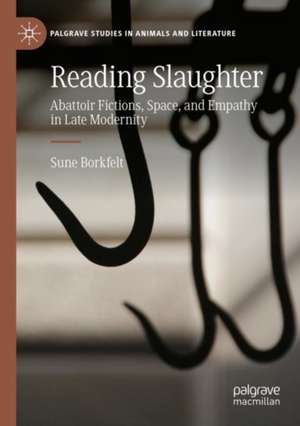Reading Slaughter: Abattoir Fictions, Space, and Empathy in Late Modernity: Palgrave Studies in Animals and Literature
Autor Sune Borkfelten Limba Engleză Paperback – 8 mai 2023
| Toate formatele și edițiile | Preț | Express |
|---|---|---|
| Paperback (1) | 724.17 lei 6-8 săpt. | |
| Springer International Publishing – 8 mai 2023 | 724.17 lei 6-8 săpt. | |
| Hardback (1) | 729.36 lei 6-8 săpt. | |
| Springer International Publishing – 7 mai 2022 | 729.36 lei 6-8 săpt. |
Din seria Palgrave Studies in Animals and Literature
- 18%
 Preț: 783.98 lei
Preț: 783.98 lei - 18%
 Preț: 893.21 lei
Preț: 893.21 lei - 18%
 Preț: 944.82 lei
Preț: 944.82 lei - 15%
 Preț: 696.02 lei
Preț: 696.02 lei - 18%
 Preț: 727.31 lei
Preț: 727.31 lei - 15%
 Preț: 589.51 lei
Preț: 589.51 lei - 18%
 Preț: 786.18 lei
Preț: 786.18 lei - 18%
 Preț: 785.42 lei
Preț: 785.42 lei - 18%
 Preț: 785.11 lei
Preț: 785.11 lei - 15%
 Preț: 699.28 lei
Preț: 699.28 lei - 18%
 Preț: 779.08 lei
Preț: 779.08 lei - 15%
 Preț: 585.08 lei
Preț: 585.08 lei - 15%
 Preț: 525.99 lei
Preț: 525.99 lei - 15%
 Preț: 585.90 lei
Preț: 585.90 lei - 18%
 Preț: 784.48 lei
Preț: 784.48 lei - 18%
 Preț: 783.05 lei
Preț: 783.05 lei - 15%
 Preț: 526.35 lei
Preț: 526.35 lei - 18%
 Preț: 891.02 lei
Preț: 891.02 lei - 18%
 Preț: 784.13 lei
Preț: 784.13 lei - 15%
 Preț: 699.77 lei
Preț: 699.77 lei -
 Preț: 383.50 lei
Preț: 383.50 lei - 15%
 Preț: 586.88 lei
Preț: 586.88 lei - 18%
 Preț: 892.59 lei
Preț: 892.59 lei - 18%
 Preț: 1131.56 lei
Preț: 1131.56 lei - 15%
 Preț: 588.18 lei
Preț: 588.18 lei - 15%
 Preț: 576.06 lei
Preț: 576.06 lei - 15%
 Preț: 585.57 lei
Preț: 585.57 lei - 15%
 Preț: 694.22 lei
Preț: 694.22 lei - 18%
 Preț: 785.11 lei
Preț: 785.11 lei - 18%
 Preț: 899.21 lei
Preț: 899.21 lei - 18%
 Preț: 732.07 lei
Preț: 732.07 lei - 18%
 Preț: 897.14 lei
Preț: 897.14 lei - 18%
 Preț: 894.46 lei
Preț: 894.46 lei -
 Preț: 384.86 lei
Preț: 384.86 lei
Preț: 724.17 lei
Preț vechi: 883.14 lei
-18% Nou
Puncte Express: 1086
Preț estimativ în valută:
138.59€ • 150.48$ • 116.41£
138.59€ • 150.48$ • 116.41£
Carte tipărită la comandă
Livrare economică 22 aprilie-06 mai
Preluare comenzi: 021 569.72.76
Specificații
ISBN-13: 9783030989170
ISBN-10: 3030989178
Pagini: 279
Ilustrații: VIII, 279 p.
Dimensiuni: 148 x 210 mm
Greutate: 0.35 kg
Ediția:1st ed. 2022
Editura: Springer International Publishing
Colecția Palgrave Macmillan
Seria Palgrave Studies in Animals and Literature
Locul publicării:Cham, Switzerland
ISBN-10: 3030989178
Pagini: 279
Ilustrații: VIII, 279 p.
Dimensiuni: 148 x 210 mm
Greutate: 0.35 kg
Ediția:1st ed. 2022
Editura: Springer International Publishing
Colecția Palgrave Macmillan
Seria Palgrave Studies in Animals and Literature
Locul publicării:Cham, Switzerland
Cuprins
1. Introduction: Fleshing Out Invisibilities.- 2. Literary Narratives and the Empathics of Slaughter.- 3. Anthropomorphism and the Abattoir.- 4. Flesh of the City: Slaughterhouses and the Urban.- 5. Ruralities and the Abattoir.- 6. Who Slaughters and Who Consumes? On Butcher(ing) Identities.- 7. Dark Spaces: The Horrific Slaughterhouse.- 8. Coda.
Recenzii
“Reading Slaughter makes an important contribution to animal studies. Well-researched and wide-ranging, it is a commendable work of survey and close reading that takes one of the key sites of human–animal relations, the slaughterhouse, and subjects it to a long overdue book-length interrogation. … it is a welcome reminder of why we have literary animal studies in the first place.” (Dominic O’Key, The Year’s Work in Critical and Cultural Theory, May 8, 2023)
Notă biografică
Sune Borkfelt lectures at Aarhus University, Denmark. His publications include articles and book chapters on nonhuman otherness, postcolonial animals, the naming of nonhuman animals, and the ethics of animal product marketing. He is also co-author of a critical research-based Danish book on hunting.
Textul de pe ultima copertă
Reading Slaughter: Abattoir Fictions, Space, and Empathy in Late Modernity examines literary depictions of slaughterhouses from the development of the industrial abattoir in the late nineteenth century to today. The book focuses on how increasing and ongoing isolation and concealment of slaughter from the surrounding society affects readings and depictions of slaughter and abattoirs in literature, and on the degree to which depictions of animals being slaughtered creates an avenue for empathic reactions in the reader or the opportunity for reflections on human-animal relations. Through chapters on abattoir fictions in relation to narrative empathy, anthropomorphism, urban spaces, rural spaces, human identities and horror fiction, Sune Borkfelt contributes to debates in literary animal studies, human-animal studies and beyond.
Caracteristici
Traces the history of slaughter and the modern abattoir Considers narrative empathy and nonhuman characters in slaughterhouse fictions Explores rural and urban spaces and the space/place dynamics of slaughterhouses
